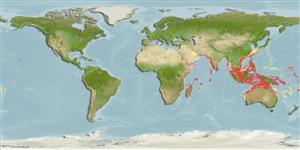Common names from other countries
Environment: milieu / climate zone / depth range / distribution range
экология
морской демерсальный; пределы глубины 18 - 92 m (Ref. 11441). Tropical
Indo-West Pacific: Persian Gulf through the eastern Indian Ocean to the East Indies.
Size / Вес / Возраст
Maturity: Lm ? range ? - ? cm
Max length : 14.0 cm TL самец/пол неопределен; (Ref. 9797)
колючие лучи спинного плавника (общее число) : 0; членистые (мягкие) лучи спинного плавника (общее число) : 65 - 77; колючие лучи анального плавника: 0; членистые (мягкие) лучи анального плавника: 41 - 50. Ground color yellowish or yellowish brown; dorsal, anal and caudal fins paler than body with dark spots. Blind side whitish. Some anterior dorsal fin rays elongated in males, not in females, all rays except a few at posterior end of fin unbranched. Pectoral fin on eyed side with 11-13 rays, on blind side with 10-13 rays. Caudal fin with 13-14 branched rays and rounded margin.
Inhabits sand and mud bottoms (Ref. 9797). Frequently collected in areas near river mouths (Ref. 9797). Feeds on bottom-living animals (Ref. 9797). Mostly used in making fish meal but is also marketed fresh (Ref. 9797).
Life cycle and mating behavior
Maturities | размножение | Spawnings | Egg(s) | Fecundities | личинки
Kuronuma, K. and Y. Abe, 1986. Fishes of the Arabian Gulf. Kuwait Institute for Scientific Research, State of Kuwait, 356 p. (Ref. 5999)
Статус Красного Списка МСОП (Ref. 130435)
CITES (Ref. 128078)
Not Evaluated
Угроза для людей
Harmless
Использование человеком
рыболовство: не имеет хозяйственного значения
дополнительная информация
инструменты
Специальные отчеты
Скачать в формате XML
ресурсы в Интернет
Estimates based on models
Preferred temperature (Ref.
115969): 23.7 - 28.6, mean 27.5 (based on 661 cells).
Phylogenetic diversity index (Ref.
82804): PD
50 = 1.0156 [Uniqueness, from 0.5 = low to 2.0 = high].
Bayesian length-weight: a=0.01122 (0.00514 - 0.02450), b=3.04 (2.87 - 3.21), in cm Total Length, based on all LWR estimates for this body shape (Ref.
93245).
Trophic level (Ref.
69278): 3.5 ±0.37 se; based on food items.
устойчивость к внешним воздействиям (Ref.
120179): высокий, минимальное время удвоения популяции до 15 месяцев (Preliminary K or Fecundity.).
Fishing Vulnerability (Ref.
59153): Low vulnerability (10 of 100).
